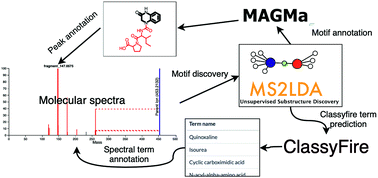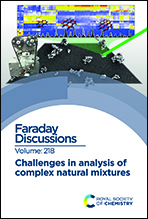Deciphering complex metabolite mixtures by unsupervised and supervised substructure discovery and semi-automated annotation from MS/MS spectra†
Abstract
Complex metabolite mixtures are challenging to unravel. Mass spectrometry (MS) is a widely used and sensitive technique for obtaining structural information of complex mixtures. However, just knowing the molecular masses of the mixture’s constituents is almost always insufficient for confident assignment of the associated chemical structures. Structural information can be augmented through MS fragmentation experiments whereby detected metabolites are fragmented, giving rise to MS/MS spectra. However, how can we maximize the structural information we gain from fragmentation spectra? We recently proposed a substructure-based strategy to enhance metabolite annotation for complex mixtures by considering metabolites as the sum of (bio)chemically relevant moieties that we can detect through mass spectrometry fragmentation approaches. Our MS2LDA tool allows us to discover – unsupervised – groups of mass fragments and/or neutral losses, termed Mass2Motifs, that often correspond to substructures. After manual annotation, these Mass2Motifs can be used in subsequent MS2LDA analyses of new datasets, thereby providing structural annotations for many molecules that are not present in spectral databases. Here, we describe how additional strategies, taking advantage of (i) combinatorial in silico matching of experimental mass features to substructures of candidate molecules, and (ii) automated machine learning classification of molecules, can facilitate semi-automated annotation of substructures. We show how our approach accelerates the Mass2Motif annotation process and therefore broadens the chemical space spanned by characterized motifs. Our machine learning model used to classify fragmentation spectra learns the relationships between fragment spectra and chemical features. Classification prediction on these features can be aggregated for all molecules that contribute to a particular Mass2Motif and guide Mass2Motif annotations. To make annotated Mass2Motifs available to the community, we also present MotifDB: an open database of Mass2Motifs that can be browsed and accessed programmatically through an Application Programming Interface (API). MotifDB is integrated within ms2lda.org, allowing users to efficiently search for characterized motifs in their own experiments. We expect that with an increasing number of Mass2Motif annotations available through a growing database, we can more quickly gain insight into the constituents of complex mixtures. This will allow prioritization towards novel or unexpected chemistries and faster recognition of known biochemical building blocks.

- This article is part of the themed collection: Challenges in analysis of complex natural mixtures


 Please wait while we load your content...
Please wait while we load your content...